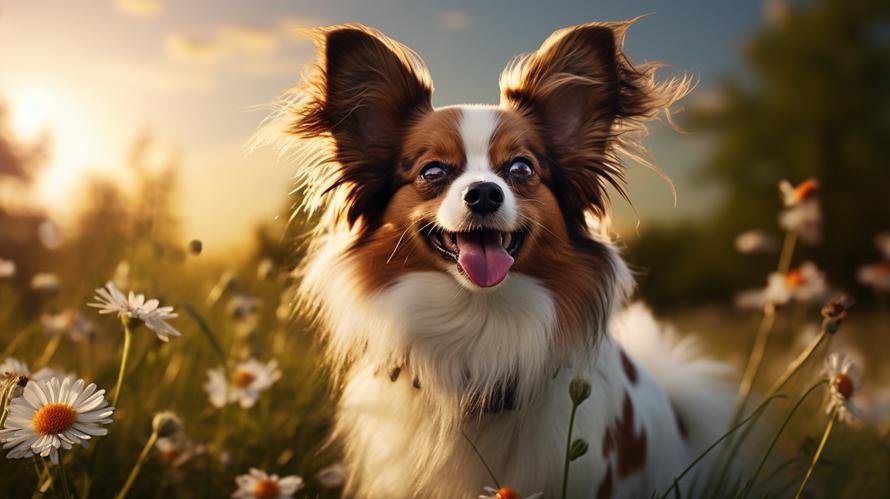Imagine this: You’re sitting on your porch on a sunny Saturday when out of the blue, a butterfly flutters by, grabbing your attention. It dances around for a moment, you’re captivated by its whimsy, then swiftly, it flies away. In many ways, the Papillon dog breed can be compared to that quick, fluttering butterfly encounter. The comparison isn’t just about their diminutive size or delicate, dainty appearance but also their name. Did you know that “Papillon” is a French term, which means butterfly, and it brilliantly reflects the butterfly-like ears of this breed?
As enchantingly charming as these doggies might be, you may have heard some rumors lately – whispers that Papillons could be dangerous. Gasp! That’s right, some folks are casting aspersions on these dainty little doggies. But don’t be too quick to judge. Let’s delve deeper and seek the truth behind these allegations.
The initial thought of the tiny Papillon being a potential threat might seem absurd. After all, these dogs usually weigh between 5 to 10 pounds and stand about 8 to 11 inches tall. Barely the size of a standard basketball, they hold pride of place as one of the most popular breeds in the Toy Group, often seen cuddling in owners’ laps or performing in agility competitions. However, danger doesn’t always come in large sizes.
Turns out, the question whether a Papillon is dangerous isn’t as clear-cut as you might have hoped. The situation, like most things in life, is somewhat muddled and that’s because danger isn’t a concrete term. It’s slippery and subjective. It hinges on personal opinions, and it’s sometimes prone to misinterpretation.
For instance, if you were asking if Papillons are physically unsafe, the answer would be – very unlikely. Because of their diminutive size, they’re hardly a physical threat to an adult human. They are not the type to launch an unprovoked attack and they typically lack the strength to cause serious harm. Essentially, if you’re picturing a direwolf from the popular show Game of Thrones, then no, a Papillon is not dangerous.
However, if you’re wondering if a Papillon can offload a slew of harmful behaviors, well, that’s a different discussion. Often, it’s the indirect dangers that fly under our radar. Let’s say your Papillon develops a relentless barking habit. This may not physically harm you, but constant noise can take a toll on your mental health and affect your productivity. Now, that’s perilous in a different way.
Similarly, Papillons are known for their high energy levels and intelligence, bordering on the cunning. If not properly trained from puppyhood, they can become dominant and develop small dog syndrome, a behavioral issue where the dog believes he’s the boss. This could lead to snapping, growling or aggressive behaviors, especially towards strangers or children who may not know how to interact with small dogs. This highlights the importance of early socialization and obedience training.
These dogs love being the center of attention and may form intense attachments to their human families. They could easily fall into separation anxiety if left alone for long hours, leading to destructive behavior such as chewing furniture, excessive barking or worse, self-harm.
When you delve into the realm of health dangers, Papillons are predisposed to certain genetic conditions like patellar luxation, a knee issue, or progressive retinal atrophy, an eye disorder. Both conditions carry their own sets of dangers, including surgery or recurring vet visits.
So, to cut the story short – classifying Papillons, or any dog breed for that matter, as dangerous can be tricky. Like humans, dogs too have complex characters moulded by a multitude of factors, including genetics, upbringing, training, socialization, and health status. Labeling an entire breed as ‘dangerous’ can be an oversimplification and perhaps even, an injustice.
In reality, the potential danger posed by a Papillon, or any dog breed, often lies more with the owner than the pet. Responsible pet ownership can go a long way in ensuring your Papillon doesn’t suffer from behavioral issues or health problems that could make them potentially harmful in any way.
Here’s a piece of useful advice – before bringing a Papillon, or any dog into your life, research diligently. Learn about their needs, demands, quirks, and if they fit into your lifestyle. Invest time and effort into their training and socialization. Provide them a safe, comfortable environment and the right diet. Don’t forget regular vet visits. All these are hallmarks of responsible pet ownership. After all, a well-bred, well-fed, well-trained, and well-loved Papillon is more a bundle of joy than a bundle of danger.
Like the fleeting moments with that captivating butterfly, owning a Papillon can be an enchantingly rewarding experience. With good training, care, and love, danger should be the last thing to worry about in regard to these adorable pets. Instead, anticipate a companion full of love, fun, and perhaps, a bit of reckless abandon, just as that butterfly on the sunny afternoon.



